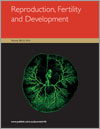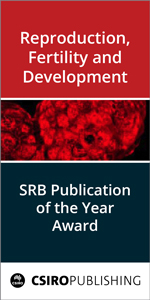Reproduction, Fertility and Development
Volume 28
Number 12 2016
In the testes D-aspartate induces testosterone synthesis, but its action in the epididymis is unknown. The effects of in vivo D-aspartate administration in rat epididymis were investigated. The findings show that D-aspartate modulates androgen and oestrogen levels and expression of their receptors by acting on 5α-reductase and P450-aromatase gene expression. Our findings support the role of D-aspartate in the male reproductive system.
Do signalling pathways in organisms work independently or dependently? To understand the precise mechanism of cell proliferation in follicular development, we conducted this study and found that synergistic effects of the transforming growth factor (TGF)-β and Notch signalling pathways play an important role in regulating granulosa cell proliferation. The interaction between the TGF-β and Notch signalling pathways found in granulosa cells may also exist in many other types of cells.
Poor fertility in lactating dairy cows is a worldwide phenomenon, which has serious financial implications, particularly in season systems of production. This study characterised lactation-induced differences in the composition of the follicular fluid, which potentially impact negatively on the developing oocyte. These data will contribute to our understanding of the factors affecting fertility and may lead to strategies to address them.
It is difficult to study the mammalian ovary in vitro because it is a complex organ that requires a three-dimensional structure to sustain follicle development and oocyte maturation. This study describes an original perfusion system for the culture of whole ovine ovaries for up to 4 days preserving follicle development and endocrine function. This system provides a relevant model for physiological and toxicological studies.
Polycystic ovary syndrome (PCOS) is one of the most common reproductive endocrine disorders. It causes abnormal ovulation and infertility in women. We established a rat PCOS model and demonstrated that appropriate concentrations of brain-derived neurotrophic factor (BDNF) promoted oocyte maturation and embryonic development in this model. Our studies indicate that BDNF may benefit women with PCOS by promoting oocyte developmental capacity and embryonic formation.
Transplantation of spermatogonial stem cells (SSCs) has theoretical and practical significance in discovering the mechanisms underlying spermatogenesis and increasing male reproduction potential. We developed a method to prepare recipients for SSCs transplantation using testicular injections of busulfan. The recipients did not die with this method and normal donor offspring were obtained. This safe method could be adapted for use in other species in the future.
Hormones play a key role during the oestrous cycle and pregnancy of the mare, but little information is available on their influence at the level of the oviduct. We used an in vitro model to establish the effect of hormones on the morphology, functionality and gene expression of the equine oviduct. The findings can be implemented in further studies on embryo–maternal interactions.
Little is known about the regulation of follicle development at the first stages (I and II) in fish or the potential role of hormones. Reproductive hormones had different effects on the ooplasm (increased presence of endoplasmic reticulum) and the granulosa–theca cell layer (reduced progression of cell cycle) of zebrafish follicles, predominantly at Stage II. These results deliver insights into the follicle development of fish species with an asynchronous mode of reproduction.
Embryos from carriers with balanced chromosomal rearrangements show distinct developmental characteristics. This study quantified embryo morphological parameters and demonstrates that morphometric characteristics are correlated with developmental outcomes as well as with chromosomal composition in embryos from carriers with balanced chromosomal rearrangements. Combining morphometric and qualitative assessment may increase the precision of embryo evaluation and contribute to improving the efficiency of preimplantation genetic diagnosis.
A practical female synchronisation strategy for marsupials is needed if artificial insemination using frozen stored spermatozoa or other assisted breeding methods are to be part of conservation breeding programs. This study investigated the potential for Lucrin Depot, a therapeutic drug used to suppress reproductive activity in humans, to regulate the marsupial cycle. The results show that Lucrin Depot suppresses reproductive activity and has the potential to synchronise the recovery of breeding activity in the fat-tailed dunnart.
Intracytoplasmic sperm injection (ICSI) is a promising tool for the conservation of animal genetic resources, but remains a challenge in birds. In this study we demonstrated that cryopreserved spermatozoa combined with ICSI followed by surrogate eggshell culture can result in fertilisation and embryo development in the quail. This study could provide technical improvements to maintain avian genetic diversity using ICSI.
Incorporation of a second polar body (PB2) with a blastomeres is considered as a causal mechanism of human 2n/3n mixoploidy. Using a mouse model, we produced 2n/3n mixoploid embryos to demonstrate their developmental competence. These embryos will be useful for understanding the production mechanism of human 2n/3n mixoploidy.
A suitable method for cryopreserving semen is needed for the conservation of endangered donkey breeds. This study compared the effect of two semen extenders and four permeating cryoprotectants on post-thaw sperm quality of Andalusian donkeys. It concluded that Gent B improved in vitro post-thaw sperm quality of donkey spermatozoa, but the replacement of glycerol with 1% ethylene glycol or 2.5% dimethylformamide increased sperm protection against cryodamage.
Embryo–uterine synchrony is critical for the establishment of pregnancy. The aim was to examine the effect of embryo–uterine synchrony on conceptus development and pregnancy in cattle. Results demonstrate the strong regulatory effect of the uterus on conceptus development and the importance of synchrony for optimal pregnancy rates.
Maternal dietary intake is important for a healthy pregnancy but it is not clear whether high intake of sugar, particularly fructose, has long-term adverse effects on the offspring. Mothers fed fructose were fatter, had mild diabetes, and poor vascular control in pregnancy; offspring did not receive fructose after birth and were heavier at 3 months but not different from control offspring at 6 months of age. Raised fructose during pregnancy resulted in poor maternal health but no major detrimental effects in offspring up to 6 months of age.
Although stallions may reach an age of >20 years, their fertility often starts to decline earlier. This study demonstrates differences in the responsiveness of testicular tissue to LH and FSH between prepubertal and mature stallions. In postpubertal stallions, no further changes occurred with increasing age. Aromatase, a key enzyme for oestrogen synthesis, seems to be of importance for the maintenance of fertility.
Due to the low success rate and poor ovarian response, female partners of infertile couple are often subjected to repeated superovulation irrespective of the type of infertility. Repeated exposures to supraphysiological levels of hormones raise concerns about the safety of this procedure on the general health of the individual, gamete quality and impact on embryonic development. In the present study, safety of repeated superovulation cycles was investigated by assessing the quality of oocytes and embryos obtained from mice subjected to repeated superovulation with a gap of 7 days between each cycle. Repeated superovulation was found to adversely affect the quality of oocytes as characterized by altered distribution of cytoplasmic organelles, spindle abnormalities, elevated oxidative stress and altered Oct-4 expression which was associated with decrease in the developmental potential of embryos.
Bovine stem cells in the testis are destined to be spermatozoa in nature, but can be reprogrammed into pluripotent stem cells in culture. We describe the development of a new culture system for bovine spermatogonial stem cells that maintains their germ-cell and pluripotent-cell characteristics. This culture system provides a feasible strategy for establishing pluripotent germ-cell lines useful for genetic modification in domestic species and preservation of endangered species.
Germ cell transplantation is an innovative technology for the production of interspecies surrogates, with the aim here of facilitating easy handling, shorter generation time and a more economical management of bluefin tuna broodstock. The present study demonstrated that transplanted southern bluefin tuna testicular germ cells migrate and colonise the gonads of yellowtail kingfish host, but do not further differentiate and proliferate.
Negative energy balance is the limiting factor for reproduction and coordination of metabolic signals in the brain is critical during female puberty. This research focused on the effects of ghrelin, a modulator of energy balance, on reproductive activity and revealed that it modulates folliculotropin secretion in peripubertal female sheep. Ghrelin belongs to the neuroendocrine network involved in the regulation of reproductive axis activity at the brain level.




